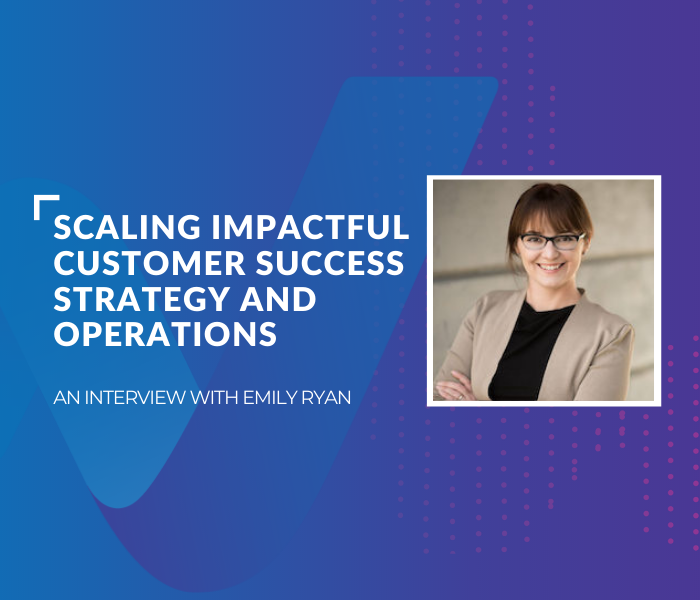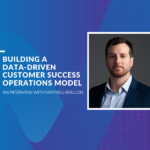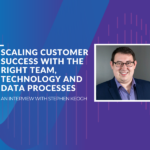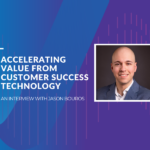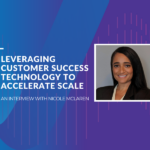Designing A Data-Driven Customer Success Organization
Strategy, technology and data are the building blocks of a strong Customer Success (CS) Operations motion. While strategy lays the groundwork, data and technology enable scalability and accelerate growth. The challenge that many B2B software companies face is determining the right blend of strategy, technology and data and leveraging each individual element to drive sustainable and scalable revenue growth.
So, what’s the secret to building and operationalizing impactful Customer Success strategies, tools and processes? To answer this, I went straight to a Customer Success Strategy & Operations expert, Emily Ryan. Emily has a strong track record as a practitioner in high-growth Customer Success organizations with leading technology companies including Splunk, Pathgather (acquired by Degreed) and States Title (now Doma; recent IPO) and now serves as Client Principal at Valuize. During our conversation, Emily offered her perspective on how to build consistent and repeatable processes that deliver optimal customer value and drive recurring revenue growth.
Q: What was your first job? How did you get started in customer success?
I’ve been working since I was a child; I was an actor when I was younger, but my first consistent, tax-paying job was as a barista at a coffee shop.
I got into Customer Success by chance and circumstance. I was working as a film and media producer in New York City when the recession of 2008 hit and things took a shift; I needed to make a change. A few of my friends worked at a tech startup (Sailthru) and referred me for a role. I initially joined as a Support Engineer out of New York City, and later became one of their first Account Managers in San Francisco. In reality, it was a Customer Success Management role, but at the time Customer Success was still being established. These two jobs launched my career in Customer Success, which was further solidified when I moved into Customer Success Operations. I was probably one of the first dozen or so people on the planet with the title ‘Director of Customer Success Operations’, so I had to make up a lot of stuff as I went along and define the role as I was doing it!
Q: Why did you decide to rejoin Valuize? What excites you most about joining Valuize?
I initially joined Valuize in 2018 to work alongside some very smart and passionate people with a strong vision to transform the Customer Success space. Soon after, I was presented with an incredible opportunity to join Splunk and be a part of an innovative software organization. Over the last two years, I’ve been able to sink my teeth into enterprise-sized operations serving as Splunk’s Director of Success Management Strategy and Operations. This has allowed me to understand the differences and, more importantly, the similarities between how organizations operate at any size.
The opportunity to now re-join Valuize as Client Principal means that I can take the breadth of knowledge I’ve gained over the course of the last decade and help more companies level up how they work, not only with their customers but also internally to deliver more value and better outcomes with their products and services.
Q: How have you seen the customer success domain change since starting your career? How do you think the domain will continue to evolve?
Business has had a Sales/Services/Support structure for a long time. When things shifted to deliver technology as a service through a renewable subscription, customer/vendor relationships and outcome management became critical beyond their previous weight. What’s emerged is the Customer Success Manager role, which in its purest form is designed to deeply understand the customer’s business strategy & pain points and inevitably help guide them to success. If you consider the customer’s goals as climbing Everest, the CSM is there as a Sherpa to help guide them up the mountain. But at the end of the day, it’s the customer that does the climbing. The Sherpa only helps them choose the right routes based on their capabilities and overall goals.
I’ve also started to see more companies recognize that the Relationship Management team, the outcome-driving folks, actually create a lot of value post-Sales. The amount of revenue that you can push in the top through Sales may feel infinite, but if all of those customers are walking out the back door, then you’re actually working with a very limited and finite pool. Companies are starting to recognize that utilizing Relationship Management and value-based outcomes is a more sustainable and powerful way to drive economic growth in a recurring revenue organization.
Q: Can you tell us about your time serving as Director, Success Management Strategy and Operations at Splunk? What was your proudest accomplishment?
Working with Splunk was an amazing opportunity for many reasons. One of the most revolutionary things that Splunk did was invest heavily in strategy and operations for Customer Success. I am very grateful that they saw the vision and the potential in CS and leaned into offering the investment to make real change happen.
This resulted in my proudest moment at Splunk; being able to work with Leadership to create and consolidate Customer Success strategy and operations into a unified dream team. These talented folks were able to chip away at the big problems that large companies often face when growing a Customer Success organization by identifying repeatable and scalable processes that reach customers in a meaningful way.
Q: In your career, how have you helped align Customer Success goals with organizational and corporate objectives to drive growth and profitability?
In my experience, a lot of organizational goals and strategies are aligned more to Sales or Business Transformation objectives, rather than the success and experience of the customers themselves. One of the most impactful solutions I’ve seen is embedding Customer Success directly into a company’s values, mission statement and top-down / bottom-up strategies.
Your company needs to ensure that the lens that they’re looking at their business growth through is the lens of the customer; how does the customer come to the table and show up? How does the customer work with these products or services? What is meaningful and valuable to them? How does what we’re doing impact or affect the customer? How can we prove that through data?
Throughout my career in Customer Success, I’ve asked these questions a lot. Just asking these questions will help your teams reframe their own approach to success and come to the table with a different perspective. That’s the most remarkable thing that I’ve tried to do in the organizations I’ve worked at. It’s definitely possible, but it does take time and dedication to achieve!
Q: Data is one of the key drivers of customer success. How can leaders ensure that they’re building and utilizing an effective customer data model that empowers CSMs to maximize customer engagement and value?
Data is definitely a major pillar of Customer Success, but I think that a lot of folks hear the word data and think of data with a capital D: quantitative metrics coming out of systems, AI and machine learning. But in reality, every single interaction that we have with our customers is a unique data point. Qualitative and relationship-based data play a key role in building a valuable customer data foundation.
By creating clarity and consistency from all of this available customer information, you can create immense value for your Customer Success Managers (CSMs), Professional Services, Sales and Senior Leadership. The customer isn’t just interacting with your CSM, they’re interacting with your product and with your Sales team for renewals, upsells or just ongoing support and relationship management. Your cross-functional teams need to have access to all of that data to create a consistent and unified customer experience.
Q: Customer Success technology is becoming an increasingly essential component of a best-in-class CS practice. What are some ways that organizations can leverage their technology investment to drive efficiency and scalability?
First of all, I would say that technology is not going to solve strategy; you cannot rely solely on technology to solve all of your Customer Success concerns. To get started, I recommend getting consistent with your team, even if you’re using spreadsheets, documents and shared messaging. You need to build a solid strategy and repeatable processes before you should be considering an investment in a Customer Success technology platform.
When you are ready to invest in a CS platform, it should be supporting and streamlining all of those processes and centralizing your customer data. Customer Success platforms and management systems help you get more value out of your data, more consistency out of your processes and lower the administrative overhead of your team, which means that your cost to serve is going to go down.
However, don’t make the mistake of diving into a Customer Success platform and expecting it to solve all of your problems. In order to work effectively, this technology must have a strong strategic foundation and iterative processes in place.
Q: When it comes to showcasing the value of Customer Success to C-Suite leadership, how would you approach that conversation and what key metrics would you recommend?
That’s a critical question. First I’ll say, I think it’s important to remember that Customer Success takes some time to bear fruit. I’ve told many folks that what we’re doing with Customer Success is prepping the ground, sowing the seeds, watering it and putting sunshine on it. That takes a long time and it takes a lot of consistency. As you go through this process and start tracking customer behaviors and impact, make sure that you’re attributing as much of that back to meaningful, value-based moments in the customer lifecycle, whether it’s a direct impact from the CSM or a CSM activity.
In terms of specific metrics, I think the most important are: Time to First Value, Recurring Value and the Return on Investment for the customer. Through these metrics, you need to showcase not only depth of customer adoption within the company, but breadth of adoption across the company. In other words, you need to track your customer’s expansion, as well as your team’s ability to get new users, new business lines and possibly new geographies enabled, engaged and receiving value.
Q: When it comes to optimizing the retention and expansion of customers, what do you see as the biggest opportunities for Customer Success leaders to pursue in 2021 and beyond?
I’d say the biggest opportunity for leaders is to empower their CSMs with better data and more consistent processes.
Consistent processes make it easy for CSMs to help their customers get what they need and ensure that everyone is focused on value-based customer outcomes as the driver for expansion and retention. We often get very focused on our own goals; what are my metrics? How fast am I going? What is my target? But, shifting that perspective to focus on the customers’ needs, problems and goals, will actually drive greater economic value for both the business and the customer. And honestly, you can’t assess what’s valuable to your customers, how much impact your adoption motion has or how heavy a deliverable is without data.
Q: What’s your favourite way to spend a Sunday?
I love spending Sundays on the patio with my dog and my husband, having good food, a nice drink and enjoying great weather. It’s either that or hiking, whether it’s an urban hike or a mountain hike. I just need some fresh air on the weekend!
Championing Data, Technology And Processes To Create A Valuable Customer Success Organization
Here are Emily’s top recommendations to take your Customer Success strategy and operations to the next level via processes, technology and data:
- To build a robust customer data model, remember to include both quantitative and qualitative metrics. Every interaction with the customer is a data point, and those relationship and engagement metrics are key to creating a consistent and unified customer understanding of the customer across your cross-functional teams.
- To empower your cross-functional teams to drive maximum value and a unified customer experience, create a data repository as your a single source of truth. Consolidate all of your customer data, both quantitative and qualitative metrics, under a solid data governance model and make it readily available to your Customer Success, Sales, Services and Product teams.
- Invest in Customer Success technology only after you’ve built a strong strategic foundation and consistent processes. With this groundwork in place, you’ll then be ready to leverage a CS platform to help your organization get more value out of data, better serve more customers and successfully scale your Customer Success organization.
By taking these strategic actions, you’re on the right track to building and scaling an unstoppable Customer Success organization. If you’re interested in expert counsel from Emily and the talented Valuize team on creating an industry-leading Customer Success strategy and operations, contact Valuize.

